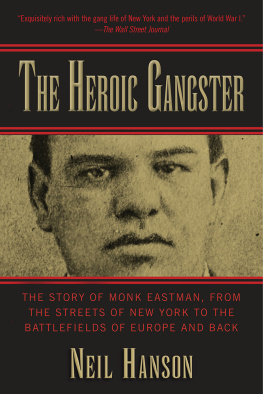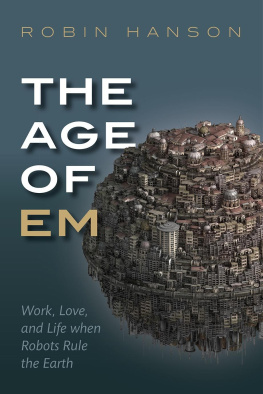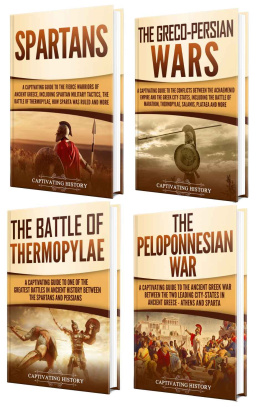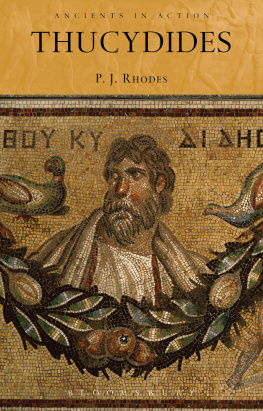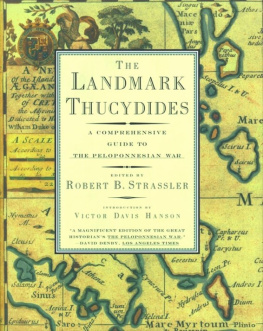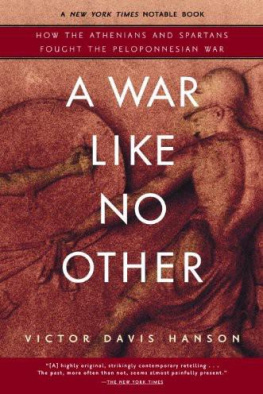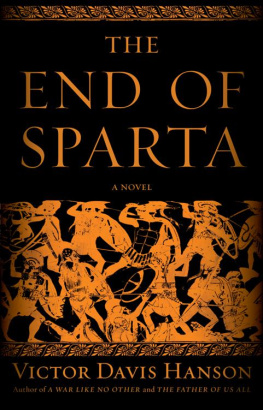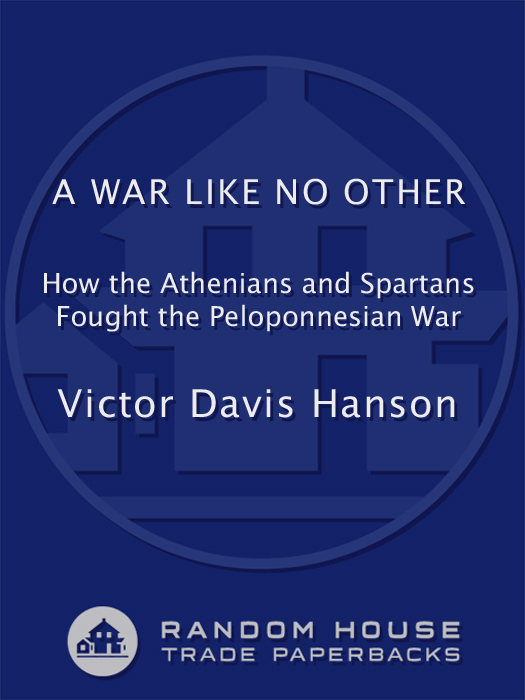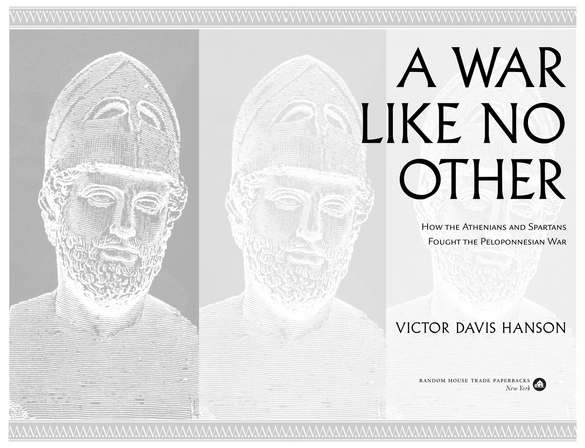PRAISE FOR A WAR LIKE NO OTHER
Definitive. Engrossing. A masterpiece. It is difficult to marshal all the requisite superlatives for Victor Davis Hansons new book on the Peloponnesian War. Hanson takes up the story where Donald Kagan, whose four-volume history of that world-altering conflict left off. Kagan provided a sweeping political and strategic overview of the war; Hanson shifts the focus and brings the reader into the guts of battle. Hansons command of his subject is as impressive as his erudition is lightly worn. Hanson, like Thucydides, teaches us about the tragic nature of war.
National Review
The age of Pericles was also a time of famine, pestilence, and atrocity: a Thirty-Year Slaughter. In order to understand the lesson this offers for civilization, one must try to feel it as the Greeks felt it, and reflect on it as they did. In this dual task, Victor Davis Hanson once again demonstrates that his qualifications are unrivaled.
C HRISTOPHER H ITCHENS ,
author of Love, Poverty, and War: Journeys and Essays
This book will immediately become the standard companion volume in English to Thucydides The Peloponnesian War. Its own battle narratives are unexcelled; but its singular merit is its comprehensive and detailed description of how the actual fighting was done, how generals led, and why each sideSparta and Athenswent to war. The author is a man of action and a practicing farmer as well as the premier classical historian and military commentator of our day.
J OSIAH B UNTING III,
author of Ulysses S. Grant
2006 Random House Trade Paperback Edition
Copyright 2005 by Victor Davis Hanson
Maps copyright 2005 by David Lindroth
All rights reserved.
Published in the United States by Random House Trade
Paperbacks, an imprint of The Random House Publishing
Group, a division of Random House, Inc., New York.
R ANDOM H OUSE T RADE P APERBACKS and colophon are trademarks of Random House, Inc.
Originally published in hardcover in the United States
by Random House, an imprint of The Random House
Publishing Group, a division of Random House, Inc., in 2005.
LIBRARY OF CONGRESS CATALOGING-IN-PUBLICATION DATA
Hanson, Victor Davis.
A war like no other: how the Athenians and Spartans
fought the Peloponnesian War / Victor Davis Hanson.
p. cm.
eISBN: 978-1-58836-490-6
I. GreeceHistoryPeloponnesian War, 431404 B.C . I. Title.
DF 229. H 36 2005 938.05dc22 2004062892
www.atrandom.com
v3.1
CONTENTS
CHAPTER 1. FEAR
Why Sparta Fought Athens (480431)
CHAPTER 2. FIRE
The War Against the Land (431425)
CHAPTER 3. DISEASE
The Ravages of the Plague at Athens (430426)
CHAPTER 4. TERROR
War in the Shadows (431421)
CHAPTER 5. ARMOR
Hoplite Pitched Battles (424418)
CHAPTER 6. WALLS
Sieges (431415)
CHAPTER 7. HORSES
The Disaster at Sicily (415413)
CHAPTER 8. SHIPS
The War at Sea (431404)
CHAPTER 9. CLIMAX
Trireme Fighting in the Aegean (411405)
CHAPTER 10. RUIN?
Winners and Losers (404403)
LIST OF MAPS
The Spartan and Athenian Empires
The Peloponnesian League and Other Spartan Allies
The Spartan and Athenian Empires
The Athenian Subject States and Allies
PROLOGUE
In April 404 B.C . the Spartan admiral Lysander finally led his vast armada of ships, crammed with some 30,000 jubilant seamen, into the hated port of Athens at the Piraeus to finish the Peloponnesian War. After the destruction of its imperial fleet at the battle of Aegospotami (Goat Rivers) in the waters off Asia Minor the prior September, the once splendid city of Athens was now utterly defenseless. Worse still was to come. It was soon surrounded, broke, jammed with refugees, starving, and near revolution. Such an end would have seemed utterly inconceivable just three decades earlier when a defiant Pericles promised his democracy victory. But then neither had 80,000 Athenians fallen to plague nor 500 ships been sunk at Sicily and on the Aegean.
Two Spartan kings, Agis and Pausanias, had encamped outside the walls of the city in command of thousands of tough infantrymen of the Peloponnese, the large peninsula south of the Isthmus at Corinth that makes up the southern part of Greece. The people of Athens were still for a time safe behind massive walls, but tens of thousands of refugees inside were cut off from both homegrown and imported foodand waiting for the end. Gone was the old lifeline of imperial tribute by land and sea. To end this growing general famine, Athens finally gave up, agreeing to dismantle most of what little was left of its once renowned fleet, famed fortifications, and vaunted democracy. Thousands of citizens were thus entirely at the mercy of Spartan clemency; perhaps 100,000 residents congregated in the streets, terrified that they might suffer the same fate they had once meted out to so many other Greeks throughout the Aegean.
The conquering Lysander wasted little time in carrying out the terms of the capitulation, most poignantly destroying most of the Long Wallstwo fortified
This book does not answer that question through a strategic account of the conflicts various campaigns. Much less is it a political study of the reasons that caused the Spartans to fight against Athens. Fine narratives in English by George Grote, George Grundy, B. W. Henderson, Donald Kagan, John Lazenby, Anton Powell, Geoffrey de Ste. Croix, and others cover those topics. So there is no need for another traditional history of the Peloponnesian War.
Instead, how did the Athenians battle the Spartans on land, in the cities, at sea, and out in the Greek countryside? What was it like for those who killed and died in this horrific war, this nightmare about which there has been little written of how many Greeks fought, how many perished, or even how all of it was conducted? My aim, therefore, after a brief introduction to the general events of the Peloponnesian War, is to flesh out this three-decade fight of some twenty-four hundred years past as something very human and thus to allow the war to become more than a far-off struggle of a distant age.
From the strange label Peloponnesian War, who imagines bloody civil strife? Most envision instead something akin to the Persian Wars, Macedonian Wars, or Dacian Wars, all tough ancient conflicts that were waged against foreign peoples. But the vast majority of lives lost between 431 and 404 were Greek. The money consumed, the towns sacked, the fields ravagedthese disasters were also mostly Greek. This ancient civil conflict today is called the Peloponnesian War since Westerners are in some respects Athenocentric. Everyone equates Athens with Greece. And while moderns are familiar with Sparta, they hear almost nothing of states such as Corinth, Syracuse, or Thebes, Athens other formidable enemies, who collectively knew the three-decade-long fight quite differently, as the Athenian War to destroy the democracy and its empire.
Most later writers, both ancient and modern, have adopted Pericles view of a war against the Peloponnesians, its history most famously written by the Athenian Thucydides. Yet in regard to the actual nature of the fighting, the Peloponnesian War was not really directed just against the Peloponnesians in open conflict but involved almost everyone in the Greek-speaking worldand many beyond it from Thrace to Persia. The struggle much more resembles the seemingly endless killing in Northern Ireland, the French and American quagmires in Vietnam, the endless chaos of the Middle East, or the Balkan crises of the 1990s rather than the more conventional battles of World War II with clear-cut enemies, theaters, fronts, and outcomes.





